CCNA – Operations 1
Here you will find answers to Operations Questions (Part 1)
Question 1:
What are two reasons that a network administrator would use access lists? (Choose two.)
A. to control vty access into a router
B. to control broadcast traffic through a router
C. to filter traffic as it passes through a router
D. to filter traffic that originates from the router
E. to replace passwords as a line of defense against security incursions
Answers: A C
Question 2:
A single 802.11g access point has been configured and installed in the center of a square office. A few wireless users are experiencing slow performance and drops while most users are operating at peak efficiency. What are three likely causes of this problem? (Choose three.)
A. mismatched TKIP encryption
B. null SSID
C. cordless phones
D. mismatched SSID
E. metal file cabinets
F. antenna type or direction
Answers: C E F
Question 3:
Refer to the exhibit. How many broadcast domains exist in the exhibited topology?
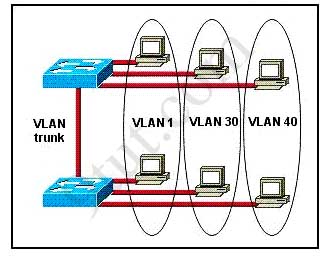
A. one
B. two
C. three
D. four
E. five
F. six
Answer: C
Question 4:
Which type of attack is characterized by a flood of packets that are requesting a TCP connection to a server?
A. denial of service
B. brute force
C. reconnaissance
D. Trojan horse
Answer: A
Question 5:
Refer to the exhibit.
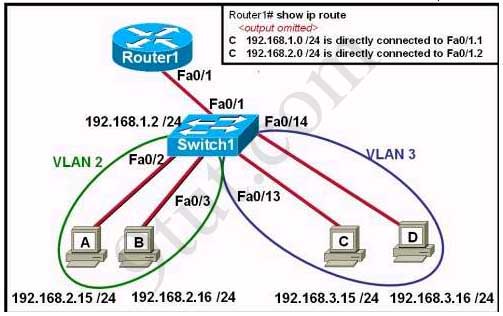
The network administrator has created a new VLAN on Switch1 and added host C and host D. The administrator has properly configured switch interfaces FastEthernet0/13 through FastEthernet0/24 to be members of the new VLAN. However, after the network administrator completed the configuration, host A could communicate with host B, but host A could not communicate with host C or host D. Which commands are required to resolve this problem?
A. Router(config)# interface fastethernet 0/1.3
Router(config-if)# encapsulation dot1q 3
Router(config-if)# ip address 192.168.3.1 255.255.255.0
B. Router(config)# router rip
Router(config-router)# network 192.168.1.0
Router(config-router)# network 192.168.2.0
Router(config-router)# network 192.168.3.0
C. Switch1# vlan database
Switch1(vlan)# vtp v2-mode
Switch1(vlan)# vtp domain cisco
Switch1(vlan)# vtp server
D. Switch1(config)# interface fastethernet 0/1
Switch1(config-if)# switchport mode trunk
Switch1(config-if)# switchport trunk encapsulation isl
Answer: A
Explanation:
Communication between host A and host B on the same VLAN does not need a router but communication between host A and host C (or host D) need a layer 3 device, in this case Router1, which is called a “router on a stick”. From the output of Router1, we notice that there is not any route to the new network 192.168.3.0/24 which host C and host D belong to. Therefore, we need to configure a subinterface for this network.
Question 6:
Refer to the exhibit. What is the most efficient summarization that R1 can use to advertise its networks to R2?
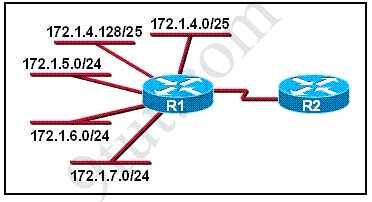
A. 172.1.0.0/22
B. 172.1.0.0/21
C. 172.1.4.0/22
D. 172.1.4.0/24
172.1.5.0/24
172.1.6.0/24
172.1.7.0/24
E. 172.1.4.0/25
172.1.4.128/25
172.1.5.0/24
172.1.6.0/24
172.1.7.0/24
Answer: C
Explanation:
Network 172.1.4.0/25 and network 172.1.4.128/25 can be grouped to a single network 172.1.4.0/24
Network 172.1.4.0/24 + Network 172.1.5.0/24 + Network 172.1.6.0/24 + Network 172.1.7.0/24 can be grouped to a single network 172.1.4.0/22 because we have all 4 subnetworks so we can move left 2 bits (22=4)
Question 7:
Which spread spectrum technology does the 802.11b standard define for operation?
A. IR
B. DSSS
C. FHSS
D. DSSS and FHSS
E. IR, FHSS, and DSSS
Answer: B
Question 8:
A network interface port has collision detection and carrier sensing enabled on a shared twisted pair network. From this statement, what is known about the network interface port?
A. This is a 10 Mb/s switch port.
B. This is a 100 Mb/s switch port.
C. This is an Ethernet port operating at half duplex.
D. This is an Ethernet port operating at full duplex.
E. This is a port on a network interface card in a PC.
Answer: C
Explanation:
Modern Ethernet networks built with switches and full-duplex connections no longer utilize CSMA/CD. CSMA/CD is only used in obsolete shared media Ethernet (which uses repeater or hub).
Question 9:
Refer to the topology and router configuration shown in the graphic. A host on the LAN is accessing an FTP server across the Internet. Which of the following addresses could appear as a source address for the packets forwarded by the router to the destination server?
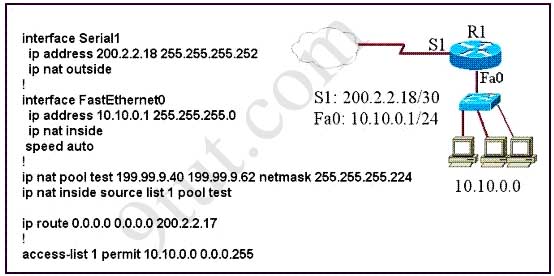
A. 10.10.0.1
B. 10.10.0.2
C. 199.99.9.33
D. 199.99.9.57
E. 200.2.2.17
F. 200.2.2.18
Answer: D
Question 10:
Which routing protocol by default uses bandwidth and delay as metrics?
A. RIP
B. BGP
C. OSPF
D. EIGRP
Answer: D
Question 11:
Refer to the exhibit. The networks connected to router R2 have been summarized as a 192.168.176.0/21 route and sent to R1. Which two packet destination addresses will R1 forward to R2? (Choose two)
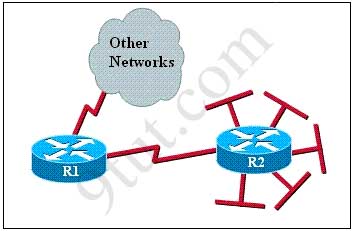
A. 192.168.194.160
B. 192.168.183.41
C. 192.168.159.2
D. 192.168.183.255
E. 192.168.179.4
F. 192.168.184.45
Answer: B E
Explanation:
From the subnet mask of /21, we can specify the network address and broadcast address of this subnetwork:
Increment: 8 of the third octet(/21 = 255.255.248.0 or 1111 1111.1111 1111. 1111 1000.0000 0000)
Network address: 192.168.176.0
Broadcast address: 192.168.183.255 (183 = 176 + 8 – 1)
Therefore all the destination addresses in this range will be forwarded to R2 -> B and E lie in this range and their packages will be forwarded to R2. Please notice that D is an incorrect answer because it is a broadcast address and R1 will drop its packages.
Question 12:
Refer to the exhibit. Which switch provides the spanning-tree designated port role for the network segment that services the printers?
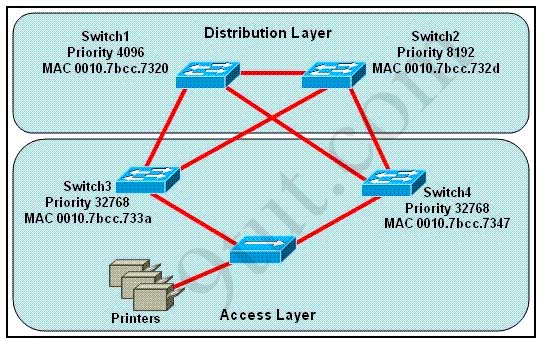
A. Switch1
B. Switch2
C. Switch3
D. Switch4
Answer: C


